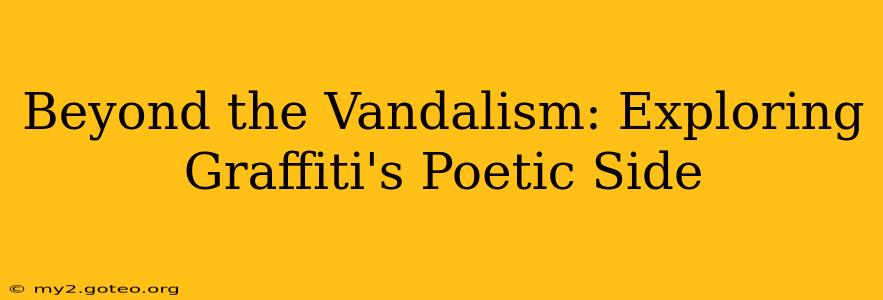Graffiti. The word itself conjures images of defaced walls, angry tags, and the frustrating cleanup efforts of city councils. But beyond the vandalism, a rich tapestry of artistic expression, social commentary, and even poetry unfolds. This art form, often misunderstood and marginalized, possesses a powerful poetic voice capable of capturing raw emotion, telling untold stories, and challenging societal norms. Let's delve deeper into the often overlooked poetic side of graffiti.
What is the difference between graffiti and street art?
This is a frequently asked question, and the line can be blurry. Generally, graffiti refers to unauthorized markings, often quick tags or throw-ups, prioritizing the name or "tag" of the artist above all else. Street art, on the other hand, is often larger, more elaborate, and frequently involves permission from property owners. While some street art might incorporate elements of graffiti, its focus is typically on a more complex visual narrative or message, often incorporating elements of fine art techniques. The key distinction often lies in intent and legality.
Is graffiti art or vandalism?
This is a question debated endlessly. The answer often depends on perspective. From a legal standpoint, most unauthorized graffiti is considered vandalism and is subject to fines or even arrest. However, from an artistic perspective, many view graffiti as a powerful form of self-expression, a vibrant visual language, and a potent form of social commentary. The art itself can be incredibly skilled, employing innovative techniques and bold aesthetics. Ultimately, it's a subjective judgment, with the line often blurred between artistic merit and illegal activity.
How does graffiti express poetic ideas?
Graffiti's poetic power lies in its ability to communicate complex emotions and ideas using minimal resources. A single, powerful tag can evoke a feeling or memory, just as a well-crafted poem can. More elaborate murals often tell stories, express social or political critiques, or capture the essence of a particular place or community. The immediacy of the art form, its placement in public spaces, and its often-rebellious nature contribute to its poetic force. It speaks directly to the viewer in a way traditional art forms often can’t. The placement itself becomes part of the poem, influencing interpretation and context.
What are some examples of poetic graffiti?
Many renowned street artists blur the lines between graffiti and art, creating pieces that are undeniably poetic. Think of the intricate wordplay and visual metaphors found in the work of artists like Banksy, whose satirical commentary frequently uses symbolic imagery to convey potent social messages. Similarly, the vibrant murals of Shepard Fairey, known for his "Hope" poster featuring Barack Obama, often employ powerful imagery and typography to create a visually stunning and politically charged narrative. These artists elevate graffiti beyond mere vandalism, transforming it into a compelling visual poetry that resonates deeply with viewers.
How can graffiti be considered a form of social commentary?
Graffiti often acts as a voice for the voiceless, a means of expressing discontent, or celebrating community pride. Pieces can highlight social injustice, economic inequality, or political corruption—providing a powerful platform for marginalized communities to articulate their experiences and perspectives. The very act of creating unauthorized art in public spaces is a form of rebellion, a challenge to the established order, and a statement in itself. This defiance, combined with the message presented, gives graffiti its inherent poetic and social power.
What are the ethical considerations surrounding graffiti art?
The ethical considerations surrounding graffiti are complex and multifaceted. While acknowledging its artistic merit, it's crucial to address the illegality of unauthorized work and the potential damage it can cause to property. Many artists and communities are working towards finding solutions that balance artistic expression with respect for the law and private property. This includes initiatives that promote legal graffiti walls or spaces dedicated to street art, creating spaces where artists can express themselves without resorting to vandalism.
Conclusion:
Graffiti, often dismissed as simple vandalism, is a multifaceted art form with a surprising poetic depth. By understanding the nuances of the art form, its varied forms of expression, and its intricate relationship with the surrounding urban landscape, we can appreciate the powerful communication and compelling narratives that this unique art form offers. While the legal and ethical considerations remain important, recognizing the potential of graffiti as a form of poetic and social commentary expands our understanding of its artistic significance.

